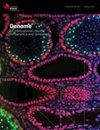Rapid karyotypic evolution with high diploid number variation in a rare genus of bromeligenous frogs.
IF 2.3
3区 生物学
Q3 BIOTECHNOLOGY & APPLIED MICROBIOLOGY
引用次数: 1
Abstract
Bromeligenous Crossodactylodes is a leptodactylid genus closely related to Paratelmatobius and Scythrophrys. The diploid number in all karyotyped species of these two latter genera is 24, which diverges from the modal diploid number (2n = 22) in the family. Here, we analyzed three species of Crossodactylodes and found karyotypes with 2n = 30, 2n = 32, and 2n = 36, diploid numbers that have not been reported in any other diploid leptodactylid species to date. Reconstruction of the ancestral chromosome number indicated that the diploid number changed from 22 to 24 in the common ancestor of Crossodactylodes, Paratelmatobius, and Scythrophrys, and that progressive increases in diploid number have occurred in Crossodactylodes. The large number of telocentric/subtelocentric chromosomes in karyotypes with higher diploid numbers raises the possibility that centric fissions may have occurred during the evolution of Paratelmatobiinae. Three metacentric chromosomes, probably involved in fission events, were inferred to be present in the common ancestor of all species of Crossodactylodes, but in C. bokermanni. Chromosome mapping of the satellite DNA PcP190 suggests homology between one arm of metacentric chromosome 1 of Crossodactylodes sp. 3 and telocentric chromosome 2 of C. itambe, supporting one of the presumed centric fission events.凤梨源蛙一个罕见属的高二倍体数目变异的快速核型进化。
Bromeliven Crossodactylodes是一个与Paratelmatobius和Scythrophrys亲缘关系密切的细趾动物属。后两个属的所有核型种的二倍体数目为24,与该科的模式二倍体数目(2n=22)不同。在这里,我们分析了三种Crossodactylodes,发现了2n=30、2n=32和2n=36的核型,这是迄今为止在任何其他二倍体细趾类物种中都没有报道过的二倍体数量。祖先染色体数目的重建表明,在Crossodactylodes、Paratelmatobius和Scythrophrys的共同祖先中,二倍体数目从22变为24,并且Crossodactolodes中的二倍体数目发生了渐进性增加。在二倍体数量较高的核型中,大量的着丝粒/近着丝粒染色体增加了在副着丝粒亚科进化过程中可能发生着丝粒分裂的可能性。三条可能与裂变事件有关的中心染色体被推断存在于所有物种的共同祖先中,但在C.bokermanni中除外。卫星DNA PcP190的染色体定位表明,Crossodactylodes sp.3的中心染色体1的一个臂与C.itambe的终心染色体2之间存在同源性,支持推测的中心分裂事件之一。
本文章由计算机程序翻译,如有差异,请以英文原文为准。
求助全文
约1分钟内获得全文
求助全文
来源期刊

Genome
生物-生物工程与应用微生物
CiteScore
5.30
自引率
3.20%
发文量
42
审稿时长
6-12 weeks
期刊介绍:
Genome is a monthly journal, established in 1959, that publishes original research articles, reviews, mini-reviews, current opinions, and commentaries. Areas of interest include general genetics and genomics, cytogenetics, molecular and evolutionary genetics, developmental genetics, population genetics, phylogenomics, molecular identification, as well as emerging areas such as ecological, comparative, and functional genomics.
 求助内容:
求助内容: 应助结果提醒方式:
应助结果提醒方式:


